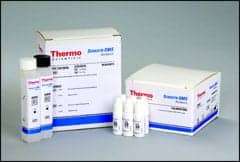 |
The annual cost of drug-related morbidity and mortality in the United States, including adverse drug reactions (ADRs), can top more than $136 million, according to the American Journal of Managed Care.1 Epidemiological studies show that ADRs occur in 5% to 20% of all hospitalized patients, and lack of therapeutic drug monitoring is one of the leading causes of preventable ADRs.
A relatively new field, therapeutic drug monitoring is the measurement of specific drugs at intervals in order to maintain a relatively constant concentration of the medication in the bloodstream. It is used to measure the level of certain medications in the blood to determine the most suitable dose and to avoid toxic effects. According to Kim Christensen, head of Syva Business of Siemens Healthcare Diagnostics, Deerfield, Ill, therapeutic drug monitoring developed in the 1970s in response to the medical community’s development and marketing of new drugs, including cardiology drugs (such as digoxin and digitoxin) to treat congestive heart failure and bronchodilators (such as theophylline) to treat asthma. An incorrect dosage of these new medications could result in toxicity.
Drugs that are monitored tend to have a narrow therapeutic range. The quantity required to be effective is not far removed from the quantity that causes significant side effects and/or signs of toxicity. Clinicians rely on therapeutic drug monitoring to measure specific drugs at intervals in order to maintain a relatively constant drug concentration in the bloodstream. Maintaining this steady state is not as simple as giving a standard dose of medication. Each person will absorb, metabolize, utilize, and eliminate drugs at a different rate based upon their age, general state of health, genetic makeup, and the interference of other medications that they are taking. This rate may change over time and vary from day to day.
Not all medications require therapeutic monitoring. Most drugs have a larger therapeutic range and can be prescribed based upon preestablished dosing schedules. The effectiveness of these treatments is evaluated, but it is not usually necessary to determine the concentration of the drug in the bloodstream. Examples of this include high blood pressure medications and many of the antibiotics given to treat bacterial infections. If the infection is cured or the blood pressure is lowered, it signifies that treatments have been effective.
By contrast, many of the therapeutically monitored drugs are taken for a lifetime and must be maintained at steady concentrations year after year while the patient ages and goes through life events such as pregnancies, temporary illnesses, infections, emotional and physical stresses, accidents, and surgeries. Over time, patients may acquire other chronic conditions that also require lifetime medication and that may affect the processing of their monitored drugs. Examples of these conditions include kidney, cardiovascular, thyroid, and liver diseases, and HIV/AIDS.
Therapeutic drug monitoring follows these changes and accommodates them. It identifies patient noncompliance, when the patient does not take the medication regularly as prescribed, and identifies the effect of drug interactions for any contraindications, which may cause drug concentrations that are higher or lower than expected at a given dosage. Thus, it helps to tailor dosages to fit the current needs of the specific patient. Monitoring can help identify decreases in the efficiency of and dysfunctions in the body in metabolizing and eliminating therapeutic drugs.
Aiming for the Therapeutic Range
Through years of testing, the optimum therapeutic blood level range for each drug has been determined. In this range, most people will be effectively treated without excessive side effects or symptoms of toxicity. The drug dosage to reach this level must be individually determined. When a patient starts on a monitored drug (or returns to it after an absence), the physician adjusts the dose and tests blood concentrations frequently until the appropriate steady-state level is achieved.
If a patient’s levels are too high, the physician will adjust them lower. Often, each different dosage level will take a short period of time to stabilize, so these corrections up and down may take place over a few days or weeks. However, if the drugs are causing symptoms associated with toxicity, the dosage will be decreased relatively rapidly to relieve these symptoms. Abrupt changes can sometimes worsen conditions and cause acute symptoms.
Once the patient’s results are in the therapeutic range, and their clinical signs indicate that the treatment is appropriate, then the drug may be monitored at regular intervals and as needed to accommodate changes in patient status to ensure that the drug stays in the therapeutic range. The frequency of testing required will depend on the drug and on the needs of the patient. If treatment does not appear to be fully effective or if the patient has either excessive side effects or signs of toxicity, then testing will be done to see if blood concentrations have become too low or high. If they have, then the dosage will be adjusted; if they have not, then the patient and physician may need to reevaluate the use of that specific medication and consider switching to another type of drug.
Testing is usually accomplished by drawing blood from a vein, most often from the inside of the elbow or the back of the hand. The site is cleaned with antiseptic.
 |
| Thermo Fisher Scientific’s Amikacin Reagants |
Product Update
According to Christensen, the commitment and expertise of a seasoned group of specialists has made Siemens’ Syva® product line the industry leader in drug testing, including therapeutic drug monitoring, for more than 40 years.
“Syva is the gold standard for drug monitoring,” Christensen says. “Our patented Emit® technology, developed in the 1960s to monitor Vietnam war veterans for drug abuse, is the only technology recognized by the United States Supreme Court as producing accurate results.”
The Viva-E® Drug Testing System features Syva Emit tests in a state-of-the-art instrument that combines a complete menu for therapeutic drug monitoring, immunosuppressive drug monitoring, drugs of abuse, and sample-validity testing on a single benchtop analyzer, plus WinTox® Data Manager. The system, which performs more than 30 tests for therapeutic and immunosuppressive drugs, as well as drugs of abuse, improves the quality and efficiency of programs that are currently performing on-site testing or sending samples to a reference laboratory.
Christensen cites the example of a patient who comes into the hospital having trouble breathing. “This could be from allergies, asthma, or obstruction of the airway,” he says. “A bronchodilator is administered, and the physician needs to determine the correct level of the drug—to ensure it is working effectively and not approaching toxic levels.”
Blood would be drawn from the patient and taken to the lab to get a serum (the product of clotted blood), which is then put on a chemistry analyzer machine in a cubit to react with a reagent to measure the baseline dosage. Once a dosage is established that produces a steady state, it is used intravenously in the hospital and then given in a pill form and measured every month.
“The testing process can take less than 30 minutes,” Christensen says. “A patient can walk in at 8 am, say he needs to know the level of his drugs, and get the results back by 10 am.”
Syva’s newest venture is testing immunosuppressant drugs, specifically, the antirejection drugs for patients with transplants. According to Christensen, it is a tedious process to get assays performed because a long extraction process of the blood is required.
“You have to get a pure sample of blood to run the test assay,” Christensen says.
A year ago, Syva perfected a test process that does not require this long pretreatment, the first and only company to provide this service, according to Christensen. The machine can test the whole blood so that a pure sample is not required.
Major transplant centers across the nation, such as the Cleveland Clinic and the Henry Ford Transplant Institute, have signed on to use the testing.
Randox, an international diagnostics company headquartered in the United Kingdom, offers therapeutic drug monitoring kits that offer excellent overall performance.
Randox therapeutic drug kits offer high-quality and reliable results. Therapeutic drug kits are available as ready-to-use liquid reagents with approximately 100 tests per kit. Analytes available include digoxin, gentamicin, lithium, phenytoin, theophylline, valproic acid, phenobarbital, and carbamazepine. Multi calibrators and controls are also available to ensure the testing process is of the highest standard. Randox therapeutic drug kits are suitable for a range of automated systems, including the RX Series of analyzers. These systems offer cost, labor, and time-saving benefits.
Beckman Coulter Inc, a leading manufacturer of diagnostics instruments in the United States and based in Orange County, Calif, has expanded its therapeutic drug monitoring test menu to include two new assays: QMS® Amikacin and QMS Quinidine.
 |
The QMS Amikacin assay measures aminoglycoside concentrations in human serum or plasma to guide and monitor dosing regimens and to evaluate toxicity and efficacy of Amikacin, an antibiotic used to treat bacterial infections.
The second new assay, QMS Quinidine, measures concentrations of the drug Quinidine in human plasma or serum. Quinidine is a major antiarrhythmic agent used to treat and prevent arrhythmias. Careful monitoring of this drug is important due to its narrow therapeutic index and similarity in patient response to subtherapeutic and toxic amounts of the drug.
Reagents and calibrators for both new assays are liquid and ready to use, which helps laboratory technicians save time by eliminating the need for mixing, hydrating, or prediluting reagents before testing.
The therapeutic drug monitoring assays available through Beckman Coulter, Fullerton, Calif, are specifically engineered and packaged to provide speed, accuracy, ease of use, and economy for the most effective analysis. When used in conjunction with a UniCel® or Synchron® clinical system, these high-quality assays provide timely, reliable, and efficient results.
- To stay up to date on toxicology testing, bookmark our website.
Beckman Coulter’s chemistry test menu is one of the most comprehensive in the industry, offering more than 100 analytes for routine chemistry, stat, and specialty testing, and including panels for lipid, cardiac, therapeutic drug monitoring, drugs of abuse, and thyroid testing.
The Amikacin and QMS Quinidine assays are manufactured by Thermo Fisher Scientific and distributed by Beckman Coulter. More than 200,000 Beckman Coulter systems operate in laboratories around the world. Recurring revenue, consisting of supplies, test kits, service, and operating-type lease payments, represents approximately 78% of the company’s 2007 annual revenue of $2.76 billion.
SHANNON ROSE IS A FREELANCE HEALTH AND MEDICAL WRITER BASED IN TEMECULA, CALIF.
Reference
- McDonnell PJ. Controlling adverse drug reactions through improved monitoring. Am J Manag Care. 2006;12(5):256-257.




